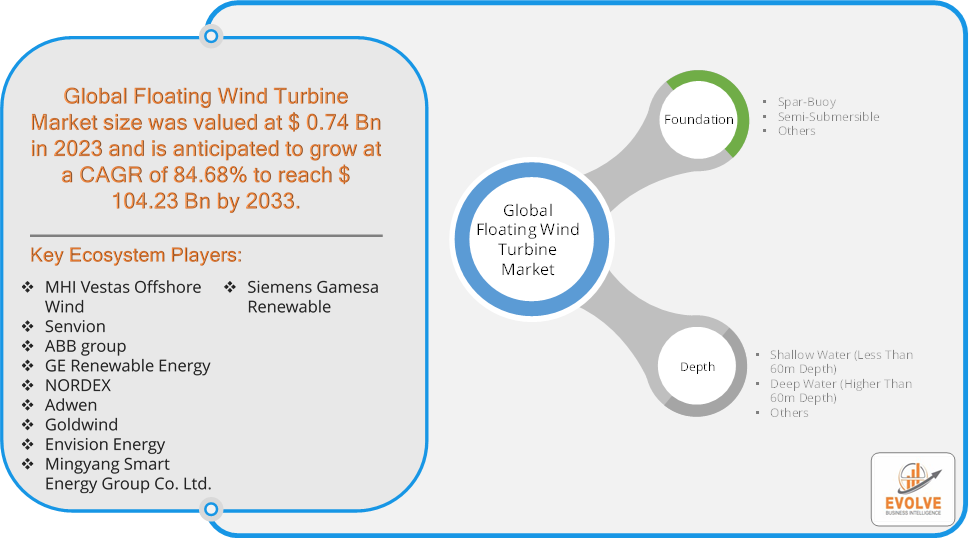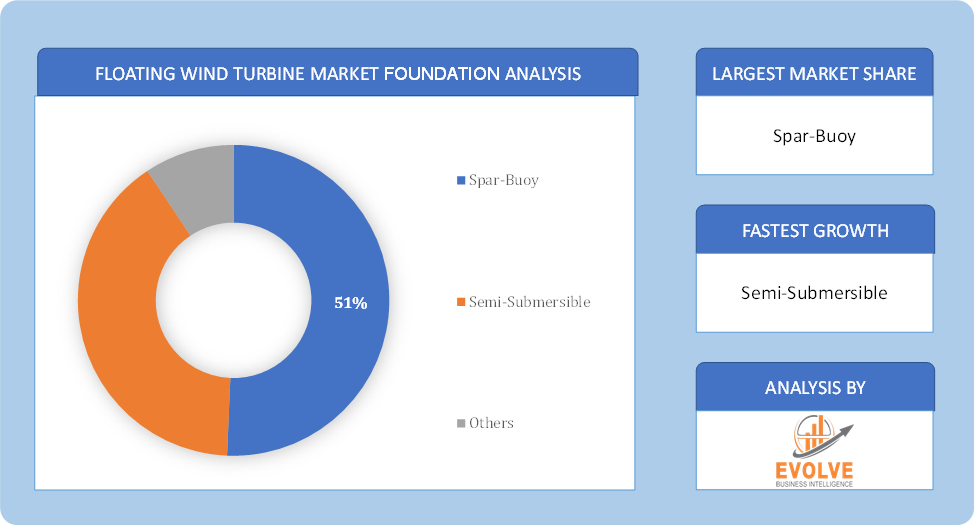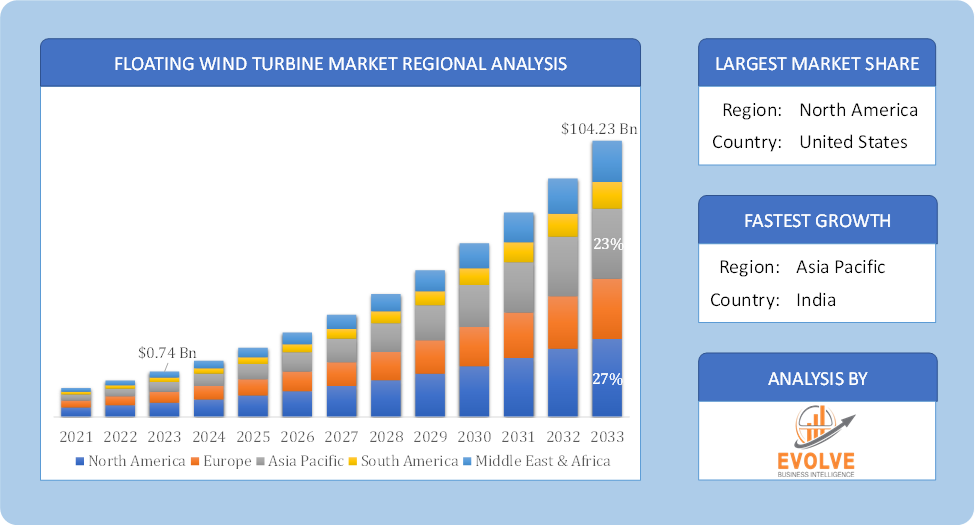Floating Wind Turbine Market Overview
The Floating Wind Turbine Market Size is expected to reach USD 104.23 Billion by 2033. The Floating Wind Turbine Market industry size accounted for USD 0.74 Billion in 2023 and is expected to expand at a compound annual growth rate (CAGR) of 84.68% from 2023 to 2033. The Floating Wind Turbine Market refers to the industry involved in the development, production, deployment, and operation of wind turbines mounted on floating structures in offshore locations. Unlike traditional offshore wind turbines that are fixed to the seabed, floating wind turbines are anchored to the ocean floor using mooring systems, allowing them to be placed in deeper waters where wind resources are typically stronger and more consistent.
The floating wind turbine market represents a promising area within the renewable energy sector, offering a sustainable solution to harnessing offshore wind resources and contributing to the global shift towards clean energy.
Global Floating Wind Turbine Market Synopsis
 COVID-19 Impact Analysis
COVID-19 Impact Analysis
The COVID-19 pandemic had a significant impact on the Floating Wind Turbine Market. The pandemic caused disruptions in global supply chains, leading to delays in the manufacturing and delivery of key components such as turbines, blades, and floating platforms. Restrictions on movement and temporary shutdowns of factories impacted production schedules. Social distancing measures and lockdowns affected the availability of personnel and equipment for the construction and installation of floating wind farms, leading to project timelines being extended. The pandemic slowed down permitting processes and regulatory approvals, as government agencies faced operational challenges and shifted priorities. The pandemic underscored the need for resilient energy systems, reinforcing commitments to transition to renewable energy sources, including floating wind. The pandemic accelerated the adoption of digital technologies and remote monitoring systems to manage operations and maintenance of wind farms, reducing the need for on-site personnel.
Floating Wind Turbine Market Dynamics
The major factors that have impacted the growth of Floating Wind Turbine Market are as follows:
Drivers:
Ø Technological Advancements
Advances in turbine technology and floating platform designs have improved the efficiency and stability of floating wind turbines, making them more competitive with traditional offshore wind solutions. Ongoing research and development have led to cost reductions in materials, manufacturing, and installation, making floating wind more economically viable. Many countries are setting ambitious targets to reduce carbon emissions and transition to renewable energy sources. Floating wind offers a significant opportunity to meet these goals. By diversifying energy sources and reducing reliance on fossil fuels, floating wind contributes to energy security and independence. As global energy demand continues to rise, floating wind provides a sustainable solution to meet the increasing need for clean electricity.
Restraint:
- Perception of High Initial Costs
The development and deployment of floating wind farms require significant upfront investment, including costs associated with research, development, materials, and specialized equipment. Securing funding for floating wind projects can be difficult due to the high initial costs and perceived risks, especially for smaller developers. The floating wind turbine industry is still developing, with a limited supply chain for specialized components and technologies, which can lead to supply bottlenecks and increased costs. A shortage of skilled professionals with expertise in offshore wind technologies can hinder the rapid scaling of the industry.
Opportunity:
⮚ Untapped Offshore Wind Resources:
Floating wind turbines can be deployed in deeper waters, where traditional fixed-bottom turbines are not feasible. These sites often have stronger and more consistent wind resources, leading to higher energy yields. Many regions around the world, including parts of Asia, Europe, and North America, have vast deep-water areas suitable for floating wind development, offering significant market expansion potential. Floating wind farms can be located farther offshore, minimizing their visual and noise impact on coastal communities. With minimal disturbance to the seabed and marine ecosystems, floating wind farms offer an environmentally friendly energy solution.
Floating Wind Turbine Market Segment Overview
 By Foundation
By Foundation
Based on Foundation, the market is segmented based on Spar-Buoy, Semi-Submersible and Others. The spar-buoy foundation segment dominated the market, due to its stabilization and simple design, which is economical for small and medium-sized rigs. Compared to TLPs and semi-submersible foundations, a spar-buoy foundation is more stable. Its structure is simpler than that of TLPs and semi-submersibles. Moreover, spar-buoy anchoring system costs are lower than TLP.
By Depth
Based on Depth, the market segment has been divided into Shallow Water (Less Than 60m Depth), Deep Water (Higher Than 60m Depth) and Others. The deep-water category generated the most income due to the wide advantage of floating wind farm installation in deep water. Deep water has higher wind speeds and no obstacles in the wind channel, which increases the ability to capture wind energy. These are the main advantages of these installations. The demand for floating wind power is driven in certain countries with a small continental shelf.
Global Floating Wind Turbine Market Regional Analysis
Based on region, the global Floating Wind Turbine Market has been divided into North America, Europe, Asia-Pacific, the Middle East & Africa, and Latin America. North America is projected to dominate the use of the Floating Wind Turbine Market followed by the Asia-Pacific and Europe regions.
 Floating Wind Turbine North America Market
Floating Wind Turbine North America Market
North America holds a dominant position in the Floating Wind Turbine Market. The U.S. has vast offshore wind resources, particularly on the West Coast and in the Gulf of Mexico, where floating wind technology is essential due to deep waters. States like California and Maine are pursuing floating wind projects.
Floating Wind Turbine Asia-Pacific Market
The Asia-Pacific region has indeed emerged as the fastest-growing market for the Floating Wind Turbine Market industry. The Asia-Pacific region is rapidly emerging as a significant market for floating wind turbines, driven by energy demand and renewable energy goals. Rapid industrial growth and energy demand present significant opportunities, although regulatory hurdles and the need for technological advancements pose challenges. Although more focused on fixed-bottom offshore wind, China is exploring floating wind projects, particularly in deep-water areas.
Competitive Landscape
The global Floating Wind Turbine Market is highly competitive, with numerous players offering a wide range of software solutions. The competitive landscape is characterized by the presence of established companies, as well as emerging startups and niche players. To increase their market position and attract a wide consumer base, the businesses are employing various strategies, such as product launches, and strategic alliances.
Prominent Players:
- MHI Vestas Offshore Wind
- Senvion
- ABB group
- GE Renewable Energy
- NORDEX
- Adwen
- Goldwind
- Envision Energy
- Mingyang Smart Energy Group Co. Ltd.
- Siemens Gamesa Renewable
Scope of the Report
Global Floating Wind Turbine Market, by Foundation
- Spar-Buoy
- Semi-Submersible
- Others
Global Floating Wind Turbine Market, by Depth
- Shallow Water (Less Than 60m Depth)
- Deep Water (Higher Than 60m Depth)
- Others
Global Floating Wind Turbine Market, by Region
- North America
- US
- Canada
- Mexico
- Europe
- UK
- Germany
- France
- Italy
- Spain
- Benelux
- Nordic
- Rest of Europe
- Asia Pacific
- China
- Japan
- South Korea
- Indonesia
- Austalia
- Malaysia
- India
- Rest of Asia Pacific
- South America
- Brazil
- Argentina
- Rest of South America
- Middle East & Africa
- Saudi Arabia
- UAE
- Egypt
- South Africa
- Rest of Middle East & Africa
| Parameters | Indicators |
|---|---|
| Market Size | 2033: USD 104.23 Billion |
| CAGR (2023-2033) | 84.68% |
| Base year | 2022 |
| Forecast Period | 2023-2033 |
| Historical Data | 2021 (2017 to 2020 On Demand) |
| Report Coverage | Revenue Forecast, Competitive Landscape, Growth Factors, and Trends |
| Key Segmentations | Foundation, Depth |
| Geographies Covered | North America, Europe, Asia-Pacific, South America, Middle East, Africa |
| Key Vendors | MHI Vestas Offshore Wind, Senvion, ABB group, GE Renewable Energy, NORDEX, Adwen, Goldwind, Envision Energy, Mingyang Smart Energy Group Co. Ltd. And Siemens Gamesa Renewable. |
| Key Market Opportunities | · Access to Untapped Offshore Wind Resources · Reduced Environmental Impact |
| Key Market Drivers | · Technological Advancements · Global Push for Renewable Energy |
REPORT CONTENT BRIEF:
- High-level analysis of the current and future Floating Wind Turbine Market trends and opportunities
- Detailed analysis of current market drivers, restraining factors, and opportunities in the future
- Floating Wind Turbine Market historical market size for the year 2021, and forecast from 2023 to 2033
- Floating Wind Turbine Market share analysis at each product level
- Competitor analysis with detailed insight into its product segment, Government & Defense strength, and strategies adopted.
- Identifies key strategies adopted including product launches and developments, mergers and acquisitions, joint ventures, collaborations, and partnerships as well as funding taken and investment done, among others.
- To identify and understand the various factors involved in the global Floating Wind Turbine Market affected by the pandemic
- To provide a detailed insight into the major companies operating in the market. The profiling will include the Government & Defense health of the company’s past 2-3 years with segmental and regional revenue breakup, product offering, recent developments, SWOT analysis, and key strategies.


 Floating Wind Turbine North America Market
Floating Wind Turbine North America Market

